Effects of 3D Roughness Parameters of Sandblasted Surface on Bond Strength of HVOF Sprayed WC-12Co Coatings
Abstract
:1. Introduction
- −
- Rz, sum of height of the largest profile peak height and the largest profile valley depth within a sampling length.
- −
- Ra, arithmetic mean of the absolute ordinate values within a sampling length.
- −
- Rq, root mean square value of the ordinate values within a sampling length.
- −
- RSk, quotient of the mean cube value of the ordinate values Z(x) and the cube of Rq, respectively, within a sampling length.
- −
- Rp, largest profile peak height within a sampling length.
- −
- Rku, quotient of the mean quadratic value of Z(x) and the fourth power of Rq within a sampling length.
- −
- Sa, this parameter expands the line roughness parameter Ra three dimensionally, represents the arithmetic mean of the absolute coordinate Z (x, y) in a defined area.
- −
- Sku, this parameter expands the line roughness parameter Rku three dimensionally, and is used to evaluate sharpness in the height distribution.
- −
- Sp, this parameter expands the line roughness parameter Rp three dimensionally. It is the maximum value for peak height.
- −
- Sq, this parameter expands the line roughness parameter Rq three dimensionally. It represents the root mean square for Z(x, y) within the evaluation area.
- −
- Ssk, this parameter expands the line roughness parameter Rsk three dimensionally; parameter Ssk, is used to evaluate deviations in the height distribution.
- −
- Sv, this parameter expands the line roughness parameter Rv three dimensionally. It is the maximum value for the valley’s depth.
- −
- Sz, this parameter expands the line roughness parameter Rz three dimensionally. The maximum height Sz is equivalent to the sum of the maximum peak height Sp and maximum valley depth Sv.
- −
- Sdq, this parameter expands the line roughness parameter Rdq three dimensionally. It indicates the mean magnitude of the local gradient (slope) of the surface. The surface is more steeply inclined as the value of the parameter Sdq becomes larger.
- −
- Sdr, this parameter signifies the rate of an increase in the surface area. The increase rate is calculated from the surface area derived by the projected area.
2. Experimental Procedures
2.1. Experimental Materials
2.2. Sandblasting Process and Samples Preparation
2.3. Test Design
3. Results and Discussion
3.1. Morphological Characteristics of Substrate Surface
3.2. Details of HVOF Coatings
3.3. Analysis of Regression Mathematical Model
3.3.1. Analysis of Linear Regression Mathematical Model
3.3.2. Analysis of Nonlinear Regression Mathematical Model
3.4. Influence Mechanisms of 3DRPs
3.4.1. Influence Mechanisms of Sa and Sdr
3.4.2. Influence Mechanisms of Sdq
3.4.3. Influence Mechanisms of Sq
4. Conclusions
- (1)
- 3D morphology shows that there are many irregular peaks and pits randomly distributed on the sandblasted surface of the substrate, with different directions and no fixed orientation. However, the sandblasted surfaces obtained by some sandblasting process parameters are characterized by fine and deep pits and widened area, which are unfavorable to the BS between TSCs and the substrate.
- (2)
- 3DRPs Sa, Sdr, Sdq and Sq of the sandblasted surface have significant effects on the BS of TSCs, which present a nonlinear regression relationship. The obtained nonlinear regression mathematical model is . According to the model, Sa, Sdr and Sdq are correlated positively with the BS, on the contrary, Sq is in inverse proportion to the BS, which further confirms that it is not that higher surface roughness of the sandblasted surfaces lead to higher BS of TSCs.
- (3)
- The influence mechanisms of the 3DRPs on the BS of TSCs are mainly concluded as follows: Sa and Sdr mainly signify the rate of an increase in the surface area and affect the contact area between the TSCs and the substrates. Sdq mainly represents the sharpness of pits and peaks on the sandblasted surface, which affects the number of anchor points for mechanical bonding of the TSCs. Sq is equal to the deviation degree of the height differences between pits and peaks on the sandblasted surface and the reference surface, which influences the quantity of coating defects and the wetting effect of interface between TSCs and the substrates.
Author Contributions
Funding
Institutional Review Board Statement
Informed Consent Statement
Data Availability Statement
Conflicts of Interest
References
- Ye, D.; Xu, Z.; Pan, J.; Yin, C.; Hu, D.; Wu, Y.; Li, R.; Li, Z. Prediction and Analysis of the Grit Blasting Process on the Corrosion Resistance of Thermal Spray Coatings Using a Hybrid Artificial Neural Network. Coatings 2021, 11, 1274. [Google Scholar] [CrossRef]
- Jiang, C.P.; Xing, Y.Z.; Zhang, F.Y.; Hao, J.M.; Song, X.C. Wear Resistance and Bond Strength of Plasma Sprayed Fe/Mo Amorphous Coatings. J. Iron Steel Res. Int. 2014, 21, 969–974. [Google Scholar] [CrossRef]
- Gonzalez-Hermosilla, W.A.; Chicot, D.; Lesage, J.; La Barbera-Sosa, J.G.; Gruescu, I.-C.; Staia, M.H.; Puchi-Cabrera, E.S. Effect of Substrate Roughness on the Fatigue Behavior of a SAE 1045 Steel Coated with a WC–10Co–4Cr Cermet, Deposited by HVOF Thermal Spray. Mater. Sci. Eng. A 2010, 527, 6551–6561. [Google Scholar] [CrossRef]
- Jiang, Y.; Liu, M.; Wang, H.Y.; Mu, X.J. Recent Development of Experimental and Numerical Analysis of Adhesion Strength of Thermal Spray Coatings. Mater. Res. Innov. 2015, 19, S5–S168. [Google Scholar] [CrossRef]
- Knapp, J.K.; Taylor, T.A. Waterjet Roughened Surface Analysis and Bond Strength. Surf. Coat. Technol. 1996, 86, 22–27. [Google Scholar] [CrossRef]
- Samson, T.; MacDonald, D.; Fernández, R.; Jodoin, B. Effect of Pulsed Waterjet Surface Preparation on the Adhesion Strength of Cold Gas Dynamic Sprayed Aluminum Coatings. J. Therm. Spray Technol. 2015, 24, 984–993. [Google Scholar] [CrossRef]
- Yang, J.; Qu, K.; Yang, J. Fatigue Performance of Q355B Steel Substrate Treated by Grit Blasting with and without Subsequent Cold Spraying with Al and Cu. Surf. Coatings Technol. 2021, 405, 126662. [Google Scholar] [CrossRef]
- Abbas, M.; Smith, G.M.; Munroe, P.R. Microstructural Study of HVOF Sprayed Ni Particles on a Grit-Blasted Stainless-Steel Substrate. Surf. Coatings Technol. 2021, 409, 126832. [Google Scholar] [CrossRef]
- Bagade, V.U.; Duraiselvam, M.; Sarangi, N.; Parthiban, K. Effect of Laser Surface Texturing on Coating Adherence and Tribological Properties of CuNiIn and MoS2 Coating. Trans. Indian Inst. Met. 2022, 75, 239–250. [Google Scholar] [CrossRef]
- Kromer, R.; Raoelison, R.N.; Danlos, Y.; Verdy, C.; Costil, S.; Liao, H. Adhesion Strength Improvement by Laser Surface Texturing of Metallic Repair Coatings Deposited by Cold Spraying. In Proceedings of the ITSC2021, Indianapolis, IN, USA, 19–22 September 2021; pp. 241–246. [Google Scholar]
- Hoffmeister, H.-W.; Schnell, C. Mechanical Roughing of Cylinder Bores in Light Metal Crankcases. Prod. Eng. 2008, 2, 365–370. [Google Scholar] [CrossRef]
- Asl, S.K.; Sohi, M.H. Effect of Grit-blasting Parameters on the Surface Roughness and Adhesion Strength of Sprayed Coating. Surf. Interface Anal. 2010, 42, 551–554. [Google Scholar] [CrossRef]
- Staia, M.H.; Ramos, E.; Carrasquero, A.; Roman, A.; Lesage, J.; Chicot, D.; Mesmacque, G. Effect of Substrate Roughness Induced by Grit Blasting upon Adhesion of WC-17% Co Thermal Sprayed Coatings. Thin Solid Film. 2000, 377, 657–664. [Google Scholar] [CrossRef]
- Day, J.; Huang, X.; Richards, N.L. Examination of a Grit-Blasting Process for Thermal Spraying Using Statistical Methods. J. Therm. Spray Technol. 2005, 14, 471–479. [Google Scholar] [CrossRef]
- Kumar, S.; Bae, G.; Lee, C. Influence of Substrate Roughness on Bonding Mechanism in Cold Spray. Surf. Coatings Technol. 2016, 304, 592–605. [Google Scholar] [CrossRef]
- Mellali, M.; Grimaud, A.; Leger, A.C.; Fauchais, P.; Lu, J. Alumina Grit Blasting Parameters for Surface Preparation in the Plasma Spraying Operation. J. Therm. Spray Technol. 1997, 6, 217–227. [Google Scholar] [CrossRef]
- Bobzin, K.; Öte, M.; Linke, T.F.; Sommer, J.; Liao, X. Influence of Process Parameter on Grit Blasting as a Pretreatment Process for Thermal Spraying. J. Therm. Spray Technol. 2016, 25, 3–11. [Google Scholar] [CrossRef]
- Varacalle, D.J.; Guillen, D.P.; Deason, D.M.; Rhodaberger, W.; Sampson, E. Effect of Grit-Blasting on Substrate Roughness and Coating Adhesion. J. Therm. Spray Technol. 2006, 15, 348–355. [Google Scholar] [CrossRef]
- Zhang, P.; Xu, G.; Liu, J.; Yi, X.; Wu, Y.; Chen, J.W. Effect of Pretreating Technologies on the Adhesive Strength and Anticorrosion Property of Zn Coated NdFeB Specimens. Appl. Surf. Sci. 2016, 363, 499–506. [Google Scholar] [CrossRef]
- Mikuliszyn, J.; Starosta, R. The Study of Linear Correlation between Surface Roughness Parameters and Adhesion of Flame Sprayed Coatings. J. KONES 2016, 23, 223–230. [Google Scholar] [CrossRef] [Green Version]
- Kumar, S.; Bae, G.; Lee, C. Deposition Characteristics of Copper Particles on Roughened Substrates through Kinetic Spraying. Appl. Surf. Sci. 2009, 255, 3472–3479. [Google Scholar] [CrossRef]
- Padmini, B.V.; Niranjan, H.B.; Kumar, R.; Padmavathi, G.; Nagabhushana, N.; Mohan, N. Influence of Substrate Roughness on the Wear Behaviour of Kinetic Spray Coating. Mater. Today Proc. 2020, 27, 2498–2502. [Google Scholar] [CrossRef]
- Schwankl, M.; Kellner, R.; Singer, R.F.; Körner, C. The Influence of Sandblasting on the Morphology of Electroless Deposited Zinclayers on Aluminum Sheets. Appl. Surf. Sci. 2013, 283, 202–208. [Google Scholar] [CrossRef]
- Matějíček, J.; Vilémová, M.; Mušálek, R.; Sachr, P.; Horník, J. The Influence of Interface Characteristics on the Adhesion/Cohesion of Plasma Sprayed Tungsten Coatings. Coatings 2013, 3, 108–125. [Google Scholar] [CrossRef] [Green Version]
- Paredes, R.S.C.; Amico, S.C.; d’Oliveira, A. The Effect of Roughness and Pre-Heating of the Substrate on the Morphology of Aluminium Coatings Deposited by Thermal Spraying. Surf. Coatings Technol. 2006, 200, 3049–3055. [Google Scholar] [CrossRef]
- Nastic, A.; Vijay, M.; Tieu, A.; Rahmati, S.; Jodoin, B. Experimental and Numerical Study of the Influence of Substrate Surface Preparation on Adhesion Mechanisms of Aluminum Cold Spray Coatings on 300M Steel Substrates. J. Therm. Spray Technol. 2017, 26, 1461–1483. [Google Scholar] [CrossRef]
- Griffiths, B.J.; Gawne, D.T.; Dong, G. The Role of Grit Blasting in the Production of High-Adhesion Plasma Sprayed Alumina Coatings. Proc. Inst. Mech. Eng. Part B J. Eng. Manuf. 1997, 211, 1–9. [Google Scholar] [CrossRef]
- Singh, R.; Rauwald, K.H.; Wessel, E.; Mauer, G.; Schruefer, S.; Barth, A.; Wilson, S.; Vassen, R. Effects of Substrate Roughness and Spray-Angle on Deposition Behavior of Cold-Sprayed Inconel 718. Surf. Coat. Technol. 2017, 319, 249–259. [Google Scholar] [CrossRef]
- Saad-Eldeen, S.; Parunov, J.; Kodvanj, J.; Saad-Eldeen, S.; Soares, C.G. Experimental Assessment of Tensile Strength of Corroded Steel Specimens Subjected to Sandblast and Sandpaper Cleaning. Mar. Struct. 2016, 49, 18–30. [Google Scholar] [CrossRef]
- Wang, Y.Q.; Yang, H.F.; Han, Q.G.; Fang, L.; Ge, S.R. Tribological and Lubrication Properties of Sandblast-Textured Surfaces with Varied Roughness. Adv. Mater. Res. 2011, 154–155, 1019–1022. [Google Scholar] [CrossRef]
- Liu, B.; Yu, H.Y.; Ye, F.; Guo, J.Y. Assessment of the Three-Dimensional Surface Roughness Parameters. In Applied Mechanics and Materials; Trans Tech Publications Ltd.: Bäch, Switzerland, 2013; Volume 274, pp. 174–178. [Google Scholar]
- Nunes, E.; de Oliveira, A.F.; Sekeres, T.; Wichern, C.; Plaut, R.L. Inter-Relationship among Skin Pass Reduction, 3d and 2d Roughness Parameters and the Stampability/Paintability of Cold Rolled Steel Sheets for the Automotive Industry: A Preliminary Analysis. In Materials Science Forum; Trans Tech Publications Ltd.: Bäch, Switzerland, 2014; Volume 783–786, pp. 1039–1045. [Google Scholar]
- Linins, O.; Krizbergs, J.; Boiko, I. Wear Estimation Using 3D Surface Roughness Parameters. In Key Engineering Materials; Trans Tech Publications Ltd.: Bäch, Switzerland, 2013; Volume 527, pp. 167–172. [Google Scholar]
- Amada, S.; Hirose, T. Planar Fractal Characteristics of Blasted Surfaces and Its Relation with Adhesion Strength of Coatings. Surf. Coat. Technol. 2000, 130, 158–163. [Google Scholar] [CrossRef]
- Sun, C.; Ning, J.; Song, Z.X.; Xie, P.; Tang, Z.S. Optimization of extraction process of total flavonoids from seabuckthorn pomace by central composite design response surface methodology. Mod. Chin. Med. 2018, 20, 74–82. [Google Scholar]
- Zi, J.Y.; Zhang, S.P.; Li, Y.Q.; Zhou, W. Optimization of diesel engine performance parameters based on response surface design. Small Intern. Combust. Engine Veh. Technol. 2020, 49, 28–34. [Google Scholar]
- Molnar, V.; Szabo, G. Designation of Minimum Measurement Area for the Evaluation of 3D Surface Texture. J. Manuf. Process. 2022, 83, 40–48. [Google Scholar] [CrossRef]
- Karmiris-Obratański, P.; Karkalos, N.E.; Kudelski, R.; Markopoulos, A.P. Experimental Study on the Effect of the Cooling Method on Surface Topography and Workpiece Integrity during Trochoidal End Milling of Incoloy 800. Tribol. Int. 2022, 176, 107899. [Google Scholar] [CrossRef]
- Javed, M.A.; Stoddart, P.R.; McArthur, S.L.; Wade, S.A. The Effect of Metal Microstructure on the Initial Attachment of Escherichia Coli to 1010 Carbon Steel. Biofouling 2013, 29, 939–952. [Google Scholar] [CrossRef]
- Wang, Q.; Chen, Z.H.; Ding, Z.X. Performance of Abrasive Wear of WC-12Co Coatings Sprayed by HVOF. Tribol. Int. 2009, 42, 1046–1051. [Google Scholar] [CrossRef]
- Santana, Y.Y.; Barbera-Sosa, L.J.G.; Caro, J.; Puchi-Cabrera, E.S.; Staia, M.H. Mechanical Properties and Microstructure of WC–10Co–4Cr and WC–12Co Thermal Spray Coatings Deposited by HVOF. Surf. Eng. 2008, 24, 374–382. [Google Scholar] [CrossRef]
- Eekhout, I.; Van De Wiel, M.A.; Heymans, M.W. Methods for Significance Testing of Categorical Covariates in Logistic Regression Models after Multiple Imputation: Power and Applicability Analysis. BMC Med. Res. Methodol. 2017, 17, 129. [Google Scholar] [CrossRef]
- Yan, Q.; Yang, K.; Wang, Z.D.; Chen, M.Z.; Sun, G.F.; Ni, Z.H. Surface Roughness Optimization and High-Temperature Wear Performance of H13 Coating Fabricated by Extreme High-Speed Laser Cladding. Opt. Laser Technol. 2022, 149, 107823. [Google Scholar] [CrossRef]
- Blochet, Q.; Delloro, F.; N’guyen, F.; Jeulin, D.; Borit, F.; Jeandin, M. Effect of the Cold-Sprayed Aluminum Coating-Substrate Interface Morphology on Bond Strength for Aircraft Repair Application. J. Therm. Spray Technol. 2017, 26, 671–686. [Google Scholar] [CrossRef]
- Begg, H.; Riley, M.; de Villiers Lovelock, H. Mechanization of the Grit Blasting Process for Thermal Spray Coating Applications: A Parameter Study. J. Therm. Spray Technol. 2016, 25, 12–20. [Google Scholar] [CrossRef]
- Peng, Y.; Zhang, C.; Zhou, H.; Liu, L. On the Bonding Strength in Thermally Sprayed Fe-Based Amorphous Coatings. Surf. Coat. Technol. 2013, 218, 17–22. [Google Scholar] [CrossRef]
- Zou, H.; Zhang, H. Effects of Sand Blasting on the TBCs Fabrication Quality. In Key Engineering Materials; Trans Tech Publications Ltd.: Bäch, Switzerland, 2013; Volume 531, pp. 290–294. [Google Scholar]
- Tan, N.; Xing, Z.; Wang, X.; Wang, H.; Jin, G.; Xu, B. Investigation of Sprayed Particle Filling Qualities within the Texture on the Bonding Behavior of Ni-Based Coating. Surf. Coat. Technol. 2017, 330, 131–139. [Google Scholar] [CrossRef]
- Liu, T.; Yu, Y.; Liu, J.; Cheng, X.; Zhang, D.; Group, B.T. Influence of Spray Process Parameters on Microstructure and Properties of AlSi-Hexagonal Boron Nitride Abradable Seal Coating. Therm. Spray Technol. 2019, 11, 24–30. [Google Scholar]
- Ivosevic, M.; Gupta, V.; Knight, R.; Cairncross, R.A.; Baldoni, J.A.; Twardowski, T.E. Effect of Substrate Roughness on Splatting Behavior of HVOF Sprayed Polymer Particles: Modeling and Experiments. J. Therm. Spray Technol. 2006, 15, 725–730. [Google Scholar] [CrossRef]


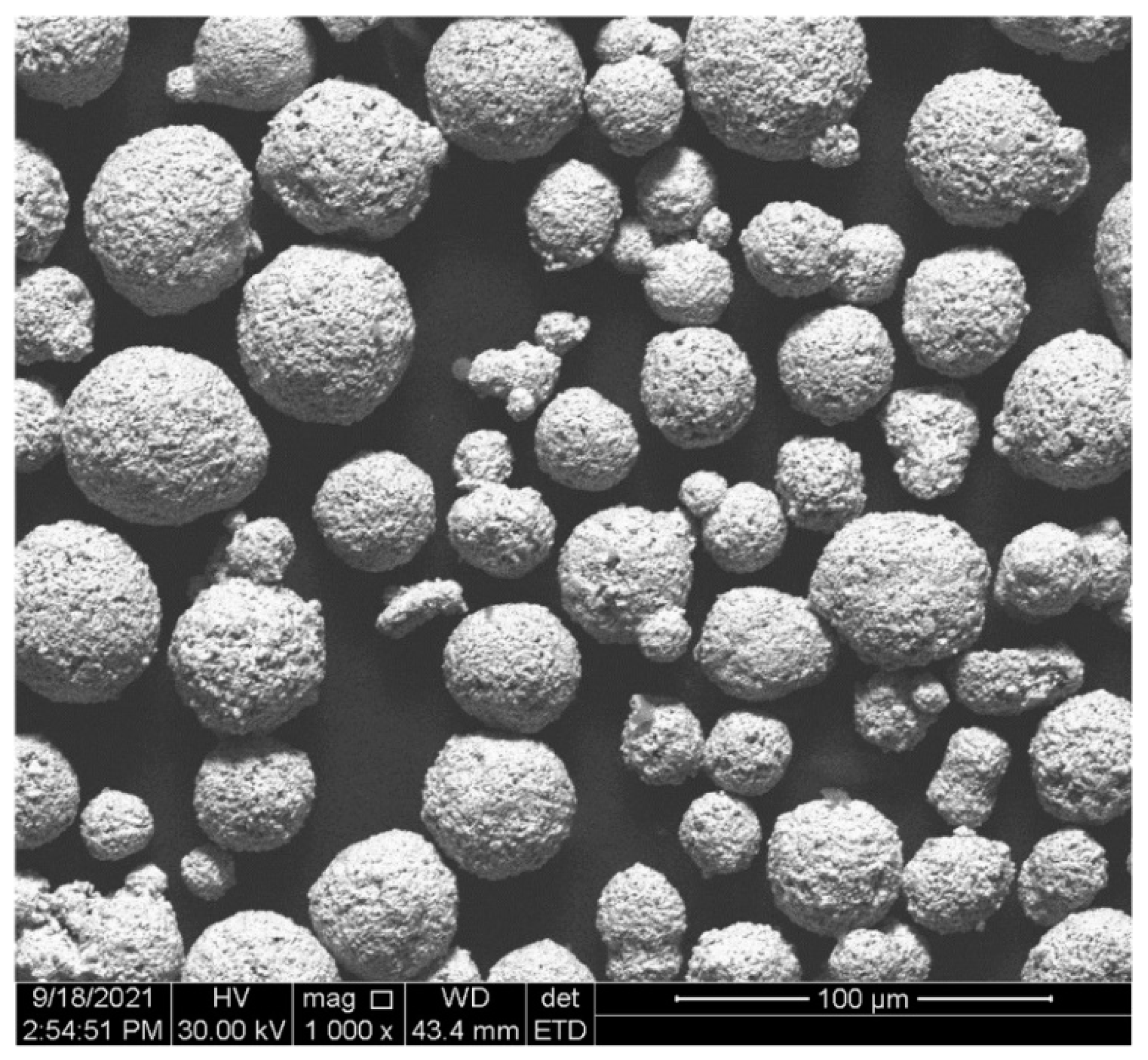
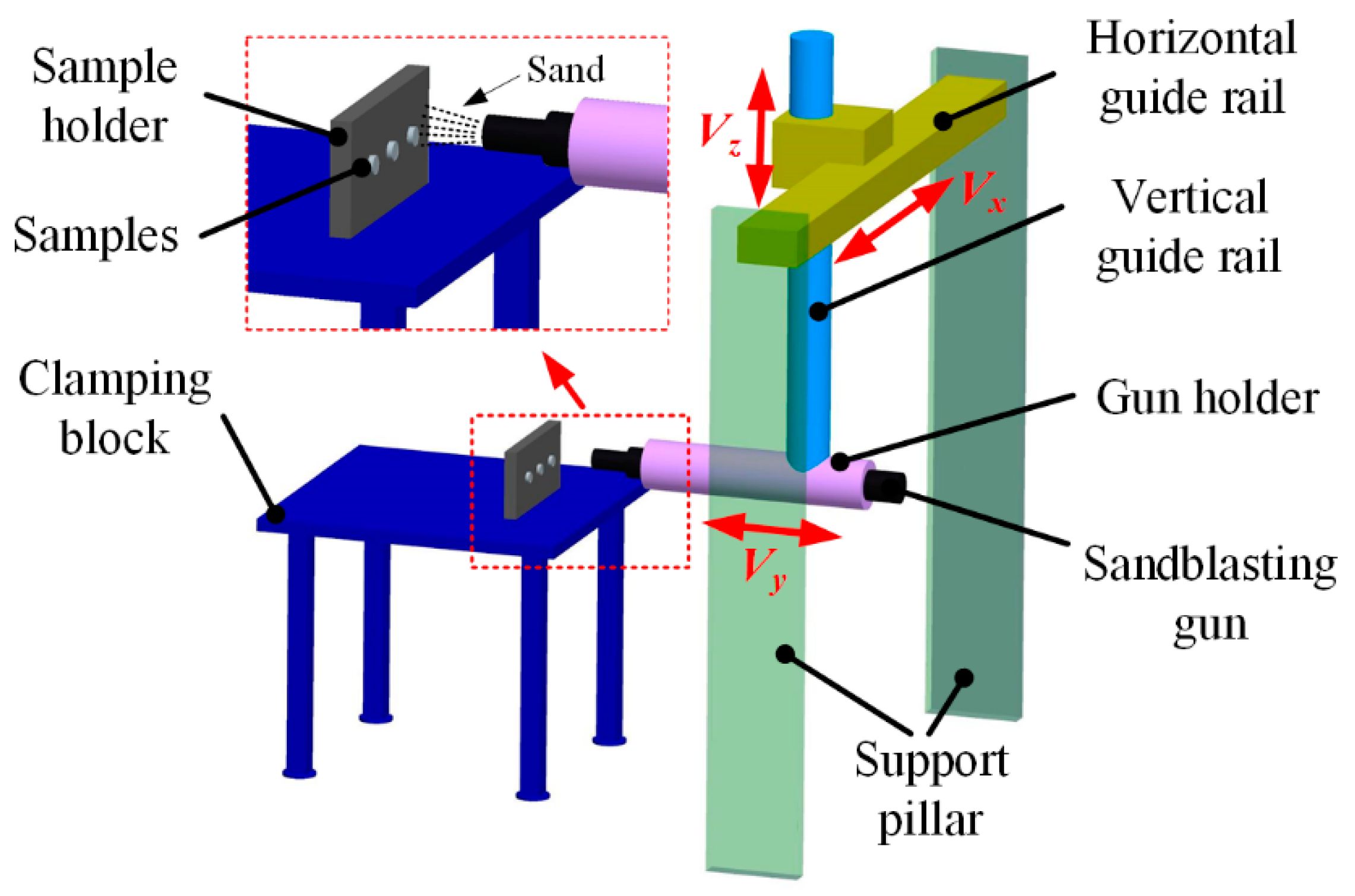

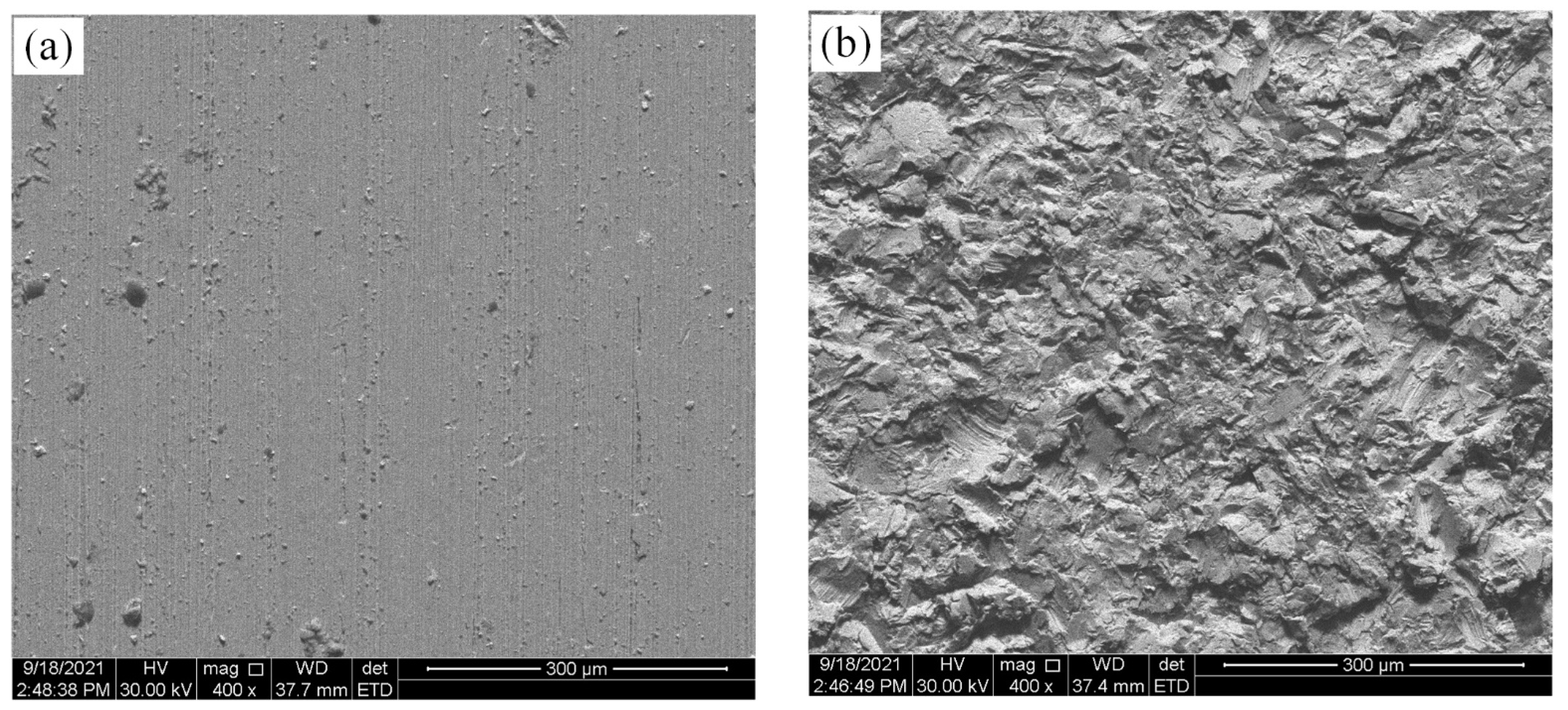


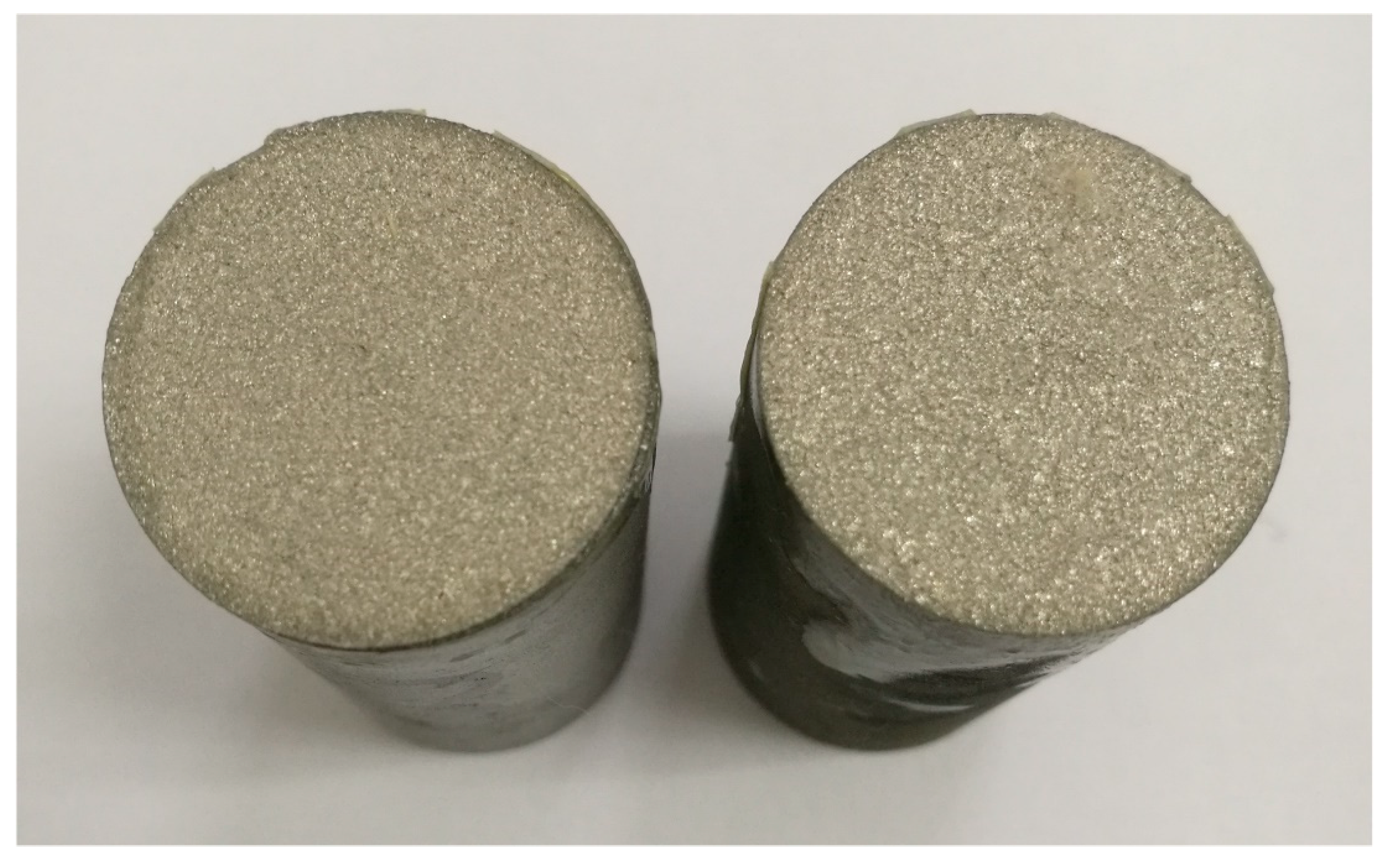
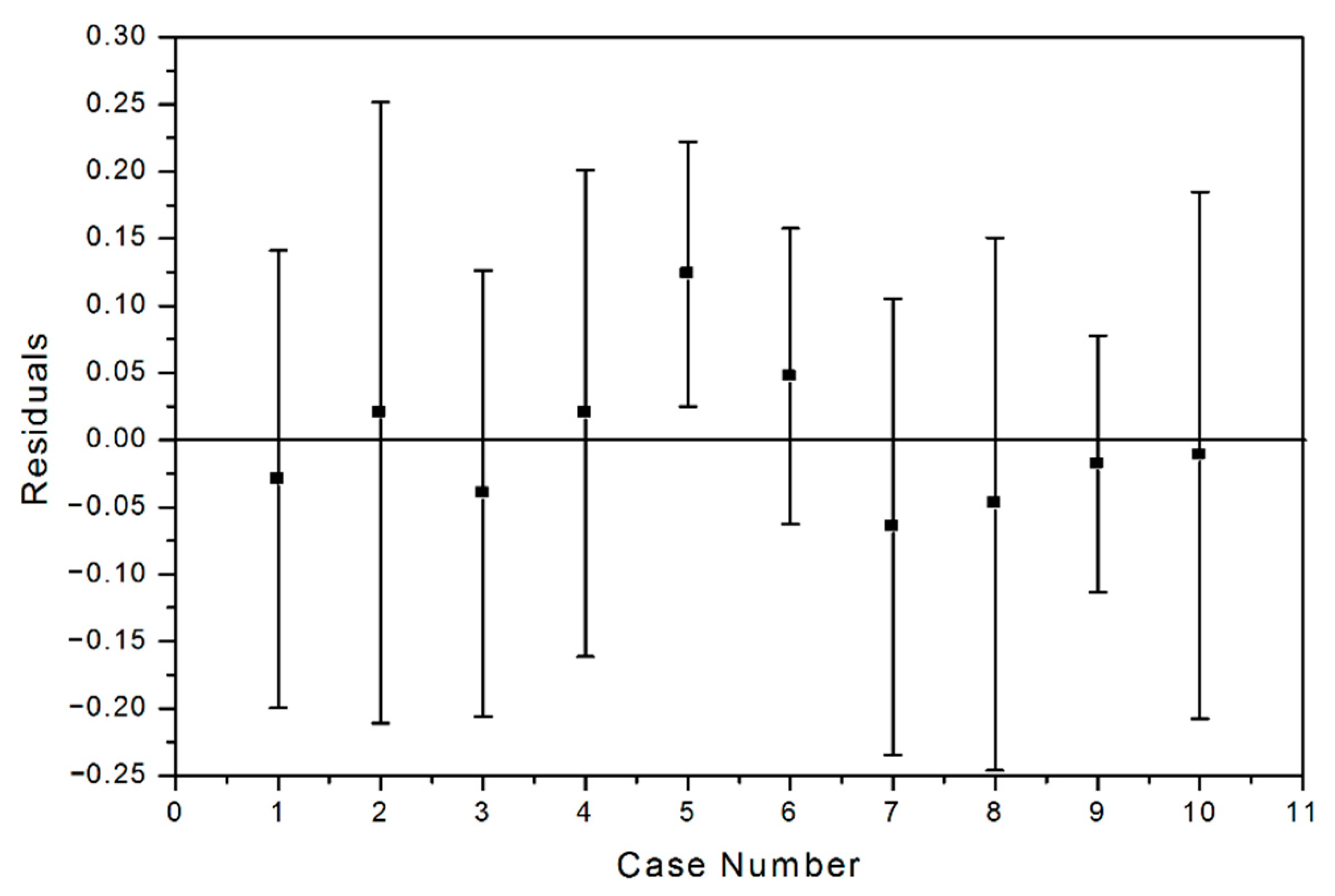



| C | Cr | Mo | Si | Mn | Fe |
|---|---|---|---|---|---|
| 0.38–0.43 | 0.8–1.1 | 0.15–0.25 | 0.15–0.35 | 0.75–1.0 | Bal. |
| Parameters | Levels | ||||
|---|---|---|---|---|---|
| −r | −1 | 0 | 1 | r | |
| Sandblasting Distance (mm) | 129.3 | 150 | 200 | 250 | 270.7 |
| Sandblasting Speed (mm/s) | 129.3 | 150 | 200 | 250 | 270.7 |
| Process | Parameters | Values |
|---|---|---|
| HVOF | Oxygen flow (SCFH) | 975 |
| Propylene flow (SCFH) | 120 | |
| Powder feed rate (g/min) | 60 | |
| Spraying distance (mm) | 180 | |
| Spraying speed (mm/s) | 1100 | |
| Layer thickness (mm) | 0.25 |
| Test NO. | SD a (mm) | SS b (mm/s) | 3DRPs | BS (MPa) | ||||||||
|---|---|---|---|---|---|---|---|---|---|---|---|---|
| Sa (μm) | Sku | Sp (μm) | Sq (μm) | Ssk | Sv (μm) | Sz (μm) | Sdq (°) | Sdr | ||||
| 1 | −1 | −1 | 5.40 ± 0.15 | 4.42 ± 0.14 | 22.55 ± 1.1 | 6.98 ± 0.25 | 0.53 ± 0.08 | 37.53 ± 2.7 | 60.08 ± 4.4 | 49.69 ± 3.4 | 53.20 ± 4.2 | 30.34 |
| 2 | −1 | −1 | 5.23 ± 0.17 | 4.27 ± 0.19 | 21.92 ± 1.8 | 6.68 ± 0.23 | 0.52 ± 0.07 | 38.84 ± 2.9 | 58.36 ± 4.1 | 48.54 ± 3.3 | 55.98 ± 3.9 | 31.33 |
| 3 | −1 | −1 | 5.38 ± 0.11 | 4.58 ± 0.10 | 21.63 ± 1.9 | 6.79 ± 0.13 | 0.55 ± 0.12 | 36.17 ± 2.1 | 59.62 ± 4.5 | 49.01 ± 3.3 | 55.50 ± 3.8 | 30.44 |
| 4 | 0 | 0 | 4.65 ± 0.17 | 3.91 ± 0.19 | 21.54 ± 1.2 | 6.12 ± 0.12 | 0.41 ± 0.08 | 34.95 ± 2.8 | 56.50 ± 4.2 | 47.42 ± 3.7 | 46.22 ± 4.0 | 27.52 |
| 5 | 0 | 0 | 4.80 ± 0.14 | 3.83 ± 0.13 | 22.12 ± 1.5 | 6.01 ± 1.1 | 0.38 ± 0.05 | 35.70 ± 2.6 | 57.60 ± 3.9 | 46.38 ± 3.1 | 47.59 ± 3.5 | 28.19 |
| 6 | 0 | 0 | 4.68 ± 0.22 | 4.04 ± 0.19 | 21.43 ± 1.5 | 6.21 ± 0.25 | 0.41 ± 0.07 | 35.65 ± 1.7 | 57.01 ± 4.0 | 47.67 ± 2.6 | 47.18 ± 3.7 | 28.34 |
| 7 | 1 | 1 | 4.27 ± 0.19 | 3.20 ± 0.23 | 22.16 ± 2.1 | 5.64 ± 0.19 | 0.19 ± 0.06 | 29.79 ± 3.0 | 51.95 ± 4.3 | 48.42 ± 3.7 | 49.29 ± 3.6 | 38.11 |
| 8 | 1 | 1 | 4.41 ± 0.13 | 3.06 ± 0.09 | 21.53 ± 1.8 | 5.56 ± 0.08 | 0.17 ± 0.05 | 31.51 ± 2.7 | 50.78 ± 3.9 | 49.56 ± 3.4 | 48.22 ± 3.7 | 36.50 |
| 9 | 1 | 1 | 4.33 ± 0.21 | 3.39 ± 0.15 | 22.79 ± 1.3 | 5.61 ± 0.26 | 0.19 ± 0.03 | 32.88 ± 2.8 | 52.33 ± 4.0 | 48.97 ± 2.8 | 49.85 ± 3.8 | 37.00 |
| 10 | 1 | −1 | 4.20 ± 0.34 | 3.78 ± 0.26 | 19.47 ± 1.5 | 5.35 ± 0.16 | 0.35 ± 0.06 | 31.93 ± 2.3 | 51.40 ± 4.1 | 46.64 ± 2.7 | 44.00 ± 4.2 | 32.47 |
| 11 | 1 | −1 | 4.35 ± 0.28 | 3.82 ± 0.26 | 18.85 ± 1.6 | 5.23 ± 0.15 | 0.33 ± 0.11 | 30.59 ± 2.9 | 49.86 ± 4.8 | 45.67 ± 3.5 | 44.61 ± 3.9 | 30.57 |
| 12 | 1 | −1 | 4.25 ± 0.11 | 3.76 ± 0.14 | 20.93 ± 1.4 | 5.27 ± 0.18 | 0.31 ± 0.03 | 32.99 ± 3.2 | 49.99 ± 4.4 | 47.73 ± 3.1 | 45.33 ± 3.7 | 31.89 |
| 13 | 0 | 0 | 5.45 ± 0.12 | 3.46 ± 0.11 | 23.23 ± 1.7 | 6.92 ± 0.11 | 0.28 ± 0.08 | 34.29 ± 1.9 | 58.52 ± 3.8 | 49.27 ± 2.8 | 51.88 ± 3.4 | 35.63 |
| 14 | 0 | 0 | 5.62 ± 0.17 | 3.30 ± 0.17 | 24.46 ± 1.6 | 6.77 ± 0.29 | 0.27 ± 0.05 | 34.21 ± 2.9 | 56.44 ± 3.6 | 48.61 ± 3.4 | 50.13 ± 3.2 | 37.82 |
| 15 | 0 | 0 | 5.61 ± 0.17 | 3.33 ± 0.13 | 25.89 ± 1.5 | 6.81 ± 0.31 | 0.27 ± 0.07 | 33.90 ± 3.1 | 57.57 ± 4.5 | 47.89 ± 3.2 | 50.51 ± 3.5 | 37.19 |
| 16 | −1 | 1 | 4.53 ± 0.08 | 3.61 ± 0.09 | 18.26 ± 1.2 | 5.79 ± 0.25 | 0.47 ± 0.10 | 32.29 ± 2.5 | 51.56 ± 4.1 | 48.30 ± 3.9 | 48.84 ± 3.4 | 38.05 |
| 17 | −1 | 1 | 4.77 ± 0.08 | 3.75 ± 0.11 | 19.01 ± 1.9 | 5.88 ± 0.13 | 0.46 ± 0.05 | 30.69 ± 2.3 | 51.35 ± 4.3 | 47.35 ± 3.6 | 47.04 ± 3.5 | 37.33 |
| 18 | −1 | 1 | 4.47 ± 0.10 | 3.50 ± 0.12 | 19.77 ± 1.7 | 5.83 ± 0.19 | 0.48 ± 0.06 | 31.19 ± 3.5 | 50.84 ± 3.6 | 48.78 ± 4.0 | 48.59 ± 3.2 | 38.63 |
| 19 | -r | 0 | 5.27 ± 0.17 | 3.61 ± 0.08 | 21.70 ± 1.3 | 6.74 ± 0.14 | 0.40 ± 0.09 | 34.74 ± 2.7 | 57.84 ± 4.1 | 48.49 ± 3.0 | 54.45 ± 3.0 | 29.62 |
| 20 | -r | 0 | 5.10 ± 0.12 | 3.72 ± 0.15 | 22.89 ± 1.6 | 6.69 ± 1.1 | 0.43 ± 0.05 | 35.40 ± 2.4 | 59.05 ± 3.8 | 47.51 ± 3.9 | 55.34 ± 3.3 | 30.29 |
| 21 | -r | 0 | 5.41 ± 0.15 | 3.58 ± 0.11 | 22.56 ± 1.5 | 6.79 ± 1.1 | 0.40 ± 0.03 | 35.85 ± 2.9 | 57.69 ± 4.4 | 47.52 ± 3.6 | 56.09 ± 3.7 | 31.36 |
| 22 | r | 0 | 5.53 ± 0.25 | 3.28 ± 0.21 | 22.56 ± 1.2 | 6.94 ± 1.1 | 0.28 ± 0.03 | 32.23 ± 2.2 | 54.79 ± 3.5 | 48.46 ± 3.3 | 61.89 ± 3.8 | 31.58 |
| 23 | r | 0 | 5.30 ± 0.21 | 3.21 ± 0.24 | 21.98 ± 1.1 | 6.88 ± 1.1 | 0.25 ± 0.09 | 33.51 ± 2.8 | 52.94 ± 3.6 | 50.34 ± 3.1 | 59.47 ± 3.1 | 30.78 |
| 24 | r | 0 | 5.46 ± 0.26 | 3.15 ± 0.20 | 21.77 ± 1.4 | 6.95 ± 1.1 | 0.24 ± 0.08 | 33.88 ± 2.2 | 53.55 ± 4.5 | 50.01 ± 4.3 | 60.17 ± 3.5 | 31.33 |
| 25 | 0 | -r | 4.31 ± 0.19 | 3.96 ± 0.15 | 17.59 ± 1.7 | 5.52 ± 1.1 | 0.48 ± 0.14 | 34.95 ± 2.7 | 52.54 ± 4.1 | 48.16 ± 3.6 | 34.50 ± 3.3 | 29.84 |
| 26 | 0 | -r | 4.54 ± 0.18 | 4.06 ± 0.17 | 17.89 ± 1.1 | 5.46 ± 1.1 | 0.43 ± 0.04 | 33.49 ± 2.9 | 51.34 ± 3.8 | 46.33 ± 3.4 | 33.91 ± 4.2 | 28.38 |
| 27 | 0 | -r | 4.40 ± 0.24 | 4.11 ± 0.22 | 16.99 ± 2.3 | 5.41 ± 1.1 | 0.43 ± 0.08 | 35.13 ± 2.8 | 53.04 ± 4.6 | 46.87 ± 3.7 | 35.87 ± 4.0 | 28.74 |
| 28 | 0 | r | 4.41 ± 0.13 | 4.36 ± 0.15 | 23.28 ± 1.3 | 5.73 ± 1.1 | 0.37 ± 0.09 | 32.93 ± 2.7 | 56.21 ± 4.4 | 48.69 ± 2.6 | 46.70 ± 3.8 | 35.05 |
| 29 | 0 | r | 4.29 ± 0.11 | 4.21 ± 0.17 | 22.78 ± 1.5 | 5.84 ± 1.1 | 0.36 ± 0.03 | 31.87 ± 2.6 | 55.38 ± 4.2 | 46.98 ± 3.6 | 47.30 ± 3.1 | 36.11 |
| 30 | 0 | r | 4.53 ± 0.08 | 4.44 ± 0.13 | 23.01 ± 1.1 | 5.88 ± 1.1 | 0.39 ± 0.03 | 32.44 ± 2.6 | 56.99 ± 4.0 | 46.76 ± 3.1 | 47.66 ± 3.9 | 33.89 |
| Element | C | Co | W | O |
|---|---|---|---|---|
| w/% | w/% | w/% | w/% | |
| Position I | 6.93 | 10.86 | 76.24 | 5.97 |
| Parameters | Evaluation | Confidence Interval |
|---|---|---|
| −98.2121 | −312.1343–115.7101 | |
| 79.1220 | −105.7682–264.0122 | |
| 3.1177 | −1.4451–7.6806 | |
| 0.4315 | −0.2761–1.1392 | |
| −1.0033 | −20.7124–18.7057 | |
| 16.4362 | −45.5166–78.3889 | |
| −68.9272 | −216.7979–78.9434 | |
| R2 | 0.6217 | |
| F-value | 2.6579 | |
| p-value | 0.3681 | |
| Parameters | Evaluation | Confidence Interval |
|---|---|---|
| −19.2499 | −48.4024–−9.9027 | |
| 13.7812 | 11.4503–39.0127 | |
| 5.2626 | 0.5997–11.1250 | |
| 0.6477 | 0.1512–1.4466 | |
| 0.0479 | −2.1529–2.2487 | |
| 0.1817 | 0.0593–0.7226 | |
| −15.2104 | −40.9664–−10.5456 | |
| R2 | 0.8826 | |
| F-value | 11.7585 | |
| p-value | 0.0523 | |
| Independent Variable | Coeff. | t-Stat | p-value |
|---|---|---|---|
| 7.7177 | 3.327 | 0.0208 | |
| 4.6459 | 2.8207 | 0.0371 | |
| 0.4352 | 2.6989 | 0.0428 | |
| 0.3043 | 0.461 | 0.6688 | |
| 0.1857 | 1.3443 | 0.25 | |
| −8.8674 | −3.647 | 0.0148 |
| Parameters | Evaluation | Confidence Interval |
|---|---|---|
| −17.6617 | −39.4122–4.0887 | |
| 7.7177 | 1.7548–13.6807 | |
| 4.6460 | 0.4120–8.8800 | |
| 0.4352 | 0.0207–0.8496 | |
| −8.8674 | −15.1177–−2.6172 | |
| R2 | 0.8293 | |
| F-value | 6.0716 | |
| p-value | 0.037 | |
Publisher’s Note: MDPI stays neutral with regard to jurisdictional claims in published maps and institutional affiliations. |
© 2022 by the authors. Licensee MDPI, Basel, Switzerland. This article is an open access article distributed under the terms and conditions of the Creative Commons Attribution (CC BY) license (https://creativecommons.org/licenses/by/4.0/).
Share and Cite
Wang, J.; Ai, C.; Yun, X.; Chen, Z.; He, B. Effects of 3D Roughness Parameters of Sandblasted Surface on Bond Strength of HVOF Sprayed WC-12Co Coatings. Coatings 2022, 12, 1451. https://doi.org/10.3390/coatings12101451
Wang J, Ai C, Yun X, Chen Z, He B. Effects of 3D Roughness Parameters of Sandblasted Surface on Bond Strength of HVOF Sprayed WC-12Co Coatings. Coatings. 2022; 12(10):1451. https://doi.org/10.3390/coatings12101451
Chicago/Turabian StyleWang, Jing, Chao Ai, Xiao Yun, Zhikai Chen, and Bing He. 2022. "Effects of 3D Roughness Parameters of Sandblasted Surface on Bond Strength of HVOF Sprayed WC-12Co Coatings" Coatings 12, no. 10: 1451. https://doi.org/10.3390/coatings12101451




